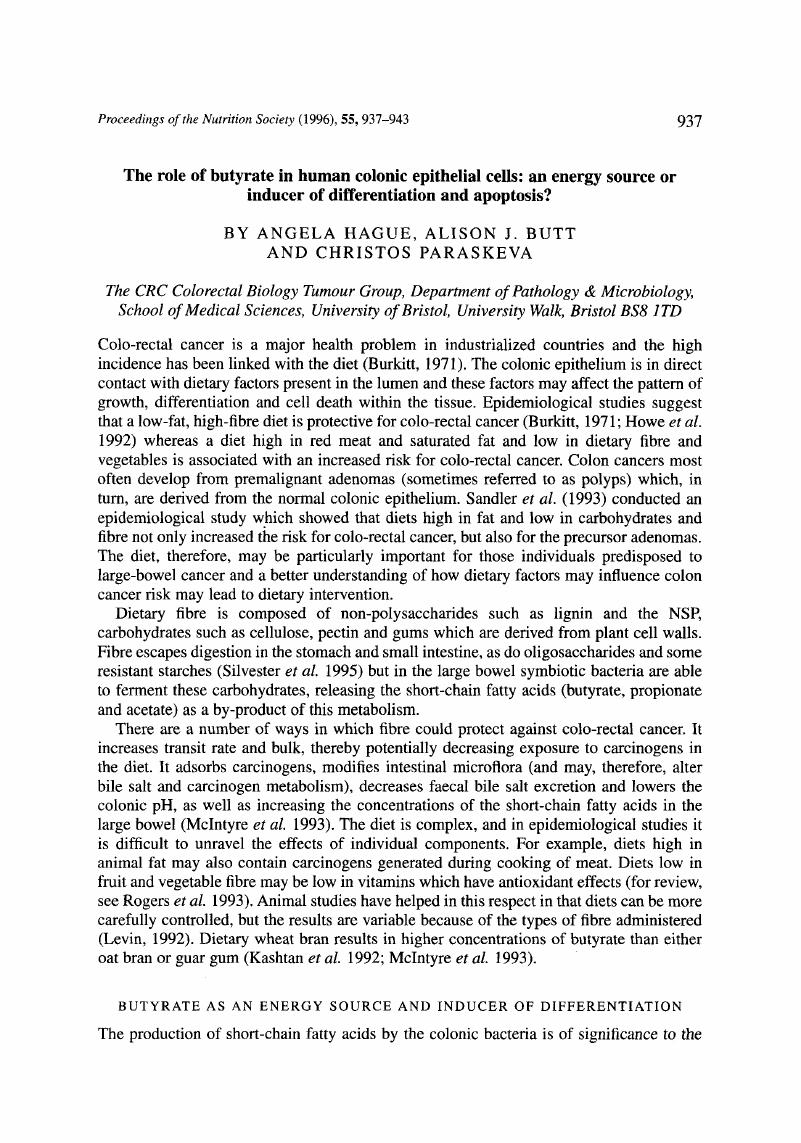Crossref Citations
This article has been cited by the following publications. This list is generated based on data provided by Crossref.
Schwartz, Bertha
Avivi-Green, Carmel
and
Polak-Charcon, Sylvie
1998.
Molecular and Cellular Effects of Nutrition on Disease Processes.
p.
21.
von Engelhardt, W.
Bartels, J.
Kirschberger, S.
zu Düttingdorf, H.D. Meyer
and
Busche, R.
1998.
Role of short‐chain fatty acids in the hind gut.
Veterinary Quarterly,
Vol. 20,
Issue. sup3,
p.
52.
Le Blay, Gwenaëlle
Michel, Catherine
Blottière, Hervé M
and
Cherbut, Christine
1999.
Prolonged Intake of Fructo-Oligosaccharides Induces a Short-Term Elevation of Lactic Acid-Producing Bacteria and a Persistent Increase in Cecal Butyrate in Rats.
The Journal of Nutrition,
Vol. 129,
Issue. 12,
p.
2231.
Wijnands, M.V.W.
Appel, M.J.
Hollanders, V.M.H.
and
Woutersen, R.A.
1999.
A comparison of the effects of dietary cellulose and fermentable galacto-oligosaccharide, in a rat model of colorectal carcinogenesis: fermentable fibre confers greater protection than non-fermentable fibre in both high and low fat backgrounds .
Carcinogenesis,
Vol. 20,
Issue. 4,
p.
651.
Compher, Charlene W.
Frankel, Wendy L.
Tazelaar, John
Lawson, John A.
McKinney, Shortie
Segall, Stanley
Kinosian, Bruce P.
Williams, Noel N.
and
Rombeau, John L.
1999.
Wheat Bran Decreases Aberrant Crypt Foci, Preserves Normal Proliferation, and Increases Intraluminal Butyrate Levels in Experimental Colon Cancer.
Journal of Parenteral and Enteral Nutrition,
Vol. 23,
Issue. 5,
p.
269.
Lupton, Joanne R
and
Turner, Nancy D
1999.
Potential protective mechanisms of wheat bran fiber.
The American Journal of Medicine,
Vol. 106,
Issue. 1,
p.
24.
Gråsten, Soile M.
Juntunen, Katri S.
Mykkänen, Hannu M.
Poutanen, Kaisa S.
Gylling, Helena K.
and
Miettinen, Tatu A.
2000.
Rye Bread Improves Bowel Function and Decreases the Concentrations of Some Compounds That Are Putative Colon Cancer Risk Markers in Middle-Aged Women and Men.
The Journal of Nutrition,
Vol. 130,
Issue. 9,
p.
2215.
Armstrong, Fiona
and
Mathers, J. C.
2000.
Kill and cure: dietary augmentation of immune defences against colon cancer.
Proceedings of the Nutrition Society,
Vol. 59,
Issue. 2,
p.
215.
Higgins, C.A.
Coaker, J.
Armstrong, F.
and
Mathers, J.C.
2000.
Dietary Anticarcinogens and Antimutagens.
p.
358.
Sowa, Yoshihiro
and
Sakai, Toshiyuki
2000.
Butyrate as a model for “Gene‐regulating chemoprevention and chemotherapy”.
BioFactors,
Vol. 12,
Issue. 1-4,
p.
283.
Avivi-Green, Carmel
Polak-Charcon, Sylvie
Madar, Zecharia
and
Schwartz, Betty
2000.
Dietary regulation and localization of apoptosis cascade proteins in the colonic crypt.
Journal of Cellular Biochemistry,
Vol. 77,
Issue. 1,
p.
18.
Johnson, I.T.
2000.
Functional Foods.
p.
141.
Kien, C. Lawrence
Chang, J.C.
and
Cooper, James R.
2000.
Butyric Acid Is Synthesized by Piglets.
The Journal of Nutrition,
Vol. 130,
Issue. 2,
p.
234.
Kovařı́ková, M
Pachernı́k, J
Hofmanová, J
Zadák, Z
and
Kozubı́k, A
2000.
TNF-α modulates the differentiation induced by butyrate in the HT-29 human colon adenocarcinoma cell line.
European Journal of Cancer,
Vol. 36,
Issue. 14,
p.
1844.
Boosalis, Michael S.
Bandyopadhyay, Ram
Bresnick, Emery H.
Pace, Betty S.
Van DeMark, Karyn
Zhang, Baohua
Faller, Douglas V.
and
Perrine, Susan P.
2001.
Short-chain fatty acid derivatives stimulate cell proliferation and induce STAT-5 activation.
Blood,
Vol. 97,
Issue. 10,
p.
3259.
Lhoste, Evelyne F
Nugon‐Baudon, Lionelle
Lory, Sandrine
Meslin, Jean‐Claude
and
Andrieux, Claude
2001.
The fermentation of lactulose in rats inoculated with Clostridium paraputrificum influences the activities of liver and intestinal xenobiotic‐metabolising enzymes.
Journal of the Science of Food and Agriculture,
Vol. 81,
Issue. 14,
p.
1397.
Yin, Lei
Laevsky, Gary
and
Giardina, Charles
2001.
Butyrate Suppression of Colonocyte NF-κB Activation and Cellular Proteasome Activity.
Journal of Biological Chemistry,
Vol. 276,
Issue. 48,
p.
44641.
Kleessen, Brigitta
Hartmann, Ludger
and
Blaut, Michael
2001.
Oligofructose and long-chain inulin: influence on the gut microbial ecology of rats associated with a human faecal flora.
British Journal of Nutrition,
Vol. 86,
Issue. 2,
p.
291.
Mathers, John C.
2002.
Pulses and carcinogenesis: potential for the prevention of colon, breast and other cancers.
British Journal of Nutrition,
Vol. 88,
Issue. S3,
p.
273.
Sengupta, Shomik
Tang, Choong‐Leong
Wong, Cynthia S. M.
Tjandra, Joe J.
and
Gibson, Peter R.
2002.
Colonic epithelial atrophy induced by a fibre‐free diet in rats is reversed by minimal amounts of luminal butyrate, but only in the short term.
ANZ Journal of Surgery,
Vol. 72,
Issue. 12,
p.
871.



